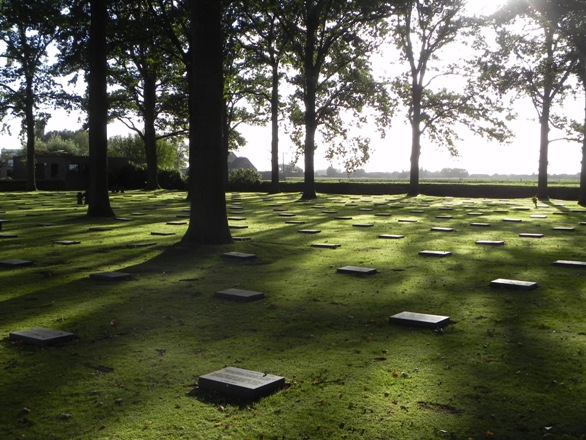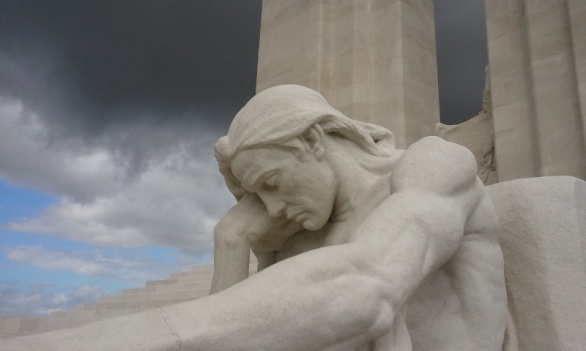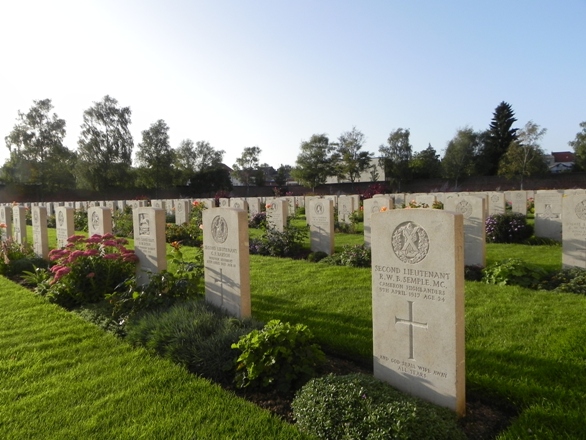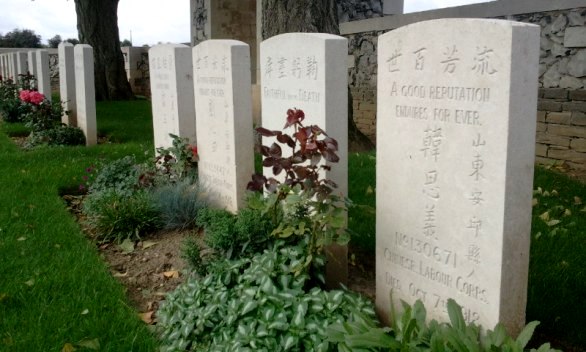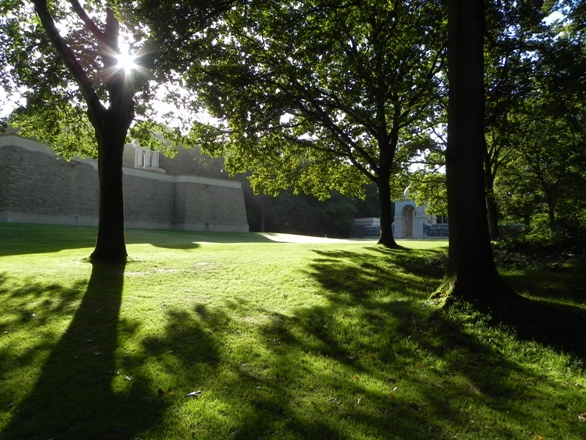Bespoke battlefield trip – following the 6th Seaforth Highlanders and New Zealand Division from Ypres & Arras to the Somme
A few weeks ago I took a couple, Mac & Marian from New Zealand, around the battlefields. They had asked me to show them around the Western front for three days before catching a train to Paris for the next leg of their trip. What made this trip so special was that we were following Corporal Andrew McDonald, 6th Seaforth Highlanders. Andrew McDonald died of wounds on 13 April 1917 and is buried at Etaples Military Cemetery. His battalion was involved in the opening stages of the Battle of Arras. It is highly probable that he was wounded when the battalion ‘went over the top’ in front of Roclincourt at 5.30am on 9 April 1917. I had previously written about the area in a piece entitled 6th Seaforth Highlanders at Roclincourt – The Battle of Arras, 9 April 1917.
After picking up Mac & Marian at Folkestone we took the tunnel over and then headed along the coast to Etaples. They told me that they had visited Second World War cemeteries before but I could see how moved they were when we pulled up at Etaples. The cemetery, the largest Commission cemetery in France, was designed by Sir Edwin Lutyens. The scale of the place defies belief and really deserves to have more visitors. After visiting Andrew’s grave and laying a small cross – something that Mac had been wanting to do for years – we spent a couple of hours just walking around this vast and sobering cemetery – the final resting place for 11,500 men and women.
Retracing our steps back up the motorway we headed to Ypres where I took them to various spots around the salient including Pilckem Ridge, Polygon Wood, Robertson’s Bridge at Reutel, The New Zealand Division Memorial at Gravenstafel, Tyne Cot Cemetery and finally the German Cemetery at Langemarck. We headed back to our excellent B&B and then back out to Ypres so we could attend the Last Post ceremony at the Menin Gate. We ate in the square before heading back to the B&B for a good sleep after a long day.
The next day was to be spent around the Arras battlefields. After a mammoth breakfast we set off south, firstly stopping at Nine Elms Cemetery at Poperinghe to pay our respects at the grave of David Gallaher, captain of the All Blacks.
We had a quick stop at Peckham and Spanbroekmolen, two of the huge craters formed by the Messines mine explosions on 7 June 1917 before heading south via Ploegsteert and into France to our next stop at La Chapelle-d’Armentières. It was here, at the site of the Railway Salient that Andrew McDonald’s brave actions during a trench raid on 15 September 1916 earned him the Military Medal. I was able to stand Mac at a spot looking down the railway line to where the German salient jutted out into No Man’s Land and explain the events of that night. We then continued south, stopping at Noeux-les-Mines Communal Cemetery & Extension to pay our respects at Marian’s great uncle, David Watson’s grave. He had been killed during the Battle of Loos whilst serving with the 1st Battalion, Cameron Highlanders. Leaving the coalfields of Gohelle behind us we began our look at the Arras battlefields.
I started with a stop at the village of La Targette with its staggering French and German cemeteries. If ever there is a place to fully appreciate the extent of losses suffered by our French allies and German foe then this is it. Neuville St Vaast Soldatenfriedhof has over 44,000 German buried within its grounds – a truly sobering place. We then headed to Vimy Ridge where, after a tour of the trenches, we headed to Walter Allward’s magnificent Vimy Memorial.
Next up was a special visit to the exact spot outside Roclincourt where ‘C’ Company, 6th Seaforths attacked on 9 April 1917. It was in the fields between the British front line and second German line (the area now contains the beautiful Highland Cemetery) that Andrew McDonald most likely received his fatal wound.
After an emotional stop at Highland Cemetery to visit other 6th Seaforth men we continued our tour through St Laurent Blangy and Athies to the Seaforths Cross at Fampoux. We then headed to the infamous village of Roeux (heavily fought over by the 51st Division in April and May 1917) and crossed the Scarpe to Monchy-le-Preux, Infantry Hill and then back down the Arras-Cambrai road to the superb Carrière Wellington tunnels. Our final stop of the day was at the Faubourg d’Amiens Cemetery & Arras Memorial to the Missing where, bathed in evening sunlight, we wandered at our leisure. After a meal in the Grande Place we headed off for a much-needed sleep.
The following morning saw us continue south down to the hallowed ground of the Somme battlefields. Mac & Marian had asked for unusual stops so, en route, we stopped at the quiet Ayette Indian & Chinese Cemetery.
Continuing south we visited Sheffield Memorial Park at Serre where I explained about the destruction of the Pals battalions of the 31st Division on 1 July 1916, the First Day of the Somme. We then headed over the Redan Ridge to Beaumont Hamel where, as well as looking at the disastrous attack by 29th Division troops on 1 July I gave a detailed explanation of the 6th Seaforth’s role in 51st Division’s successful attack on the village bastion on 13 November. We then visited Mailly Wood Cemetery to visit the graves of 6th Seaforths men killed in that attack. Most notably I had wanted them to visit the grave of 2/Lt Donald Jenkins MC. He had won his Military Cross in the same raid that earned Andrew his Military Medal – in fact, both men had crossed No Man’s Land three times bringing back wounded men on each occasion. Undoubtedly, despite the officer/other rank divide there would have been some connection between Andrew and this officer now lying at peace in Mailly Wood Cemetery.
Other stops that afternoon included a good stroll around Newfoundland Memorial Park, the Ulster Tower and Thiepval Memorial to the Missing. Having stopped at Mash Valley I took Mac & Marian on a private tour of the Glory Hole at La Boisselle (http://www.laboisselleproject.com/) before our final stops of the day at the Caterpillar Valley Cemetery for the New Zealand Memorial to Missing from September/October 1916 and the New Zealand Division Memorial at Longueval.

Early evening at Caterpillar Valley Cemetery. A ray of sun pierces through the clouds to strike the ground.
Passing High Wood I was able to point out the position of Seaforth Trench, dug by 6th Seaforths in July 1916 before heading off to our B&B at Flers for a well deserved beer, meal and chat.
The final day dawned with beautiful sunshine and so, rather than dropping Mac & Marian off in Amiens as had been agreed, I took them just down the road to Delville Wood and the South African Memorial. We were the first ones to visit that day and the atmosphere and light were quite superb.
After a circuitous tour to Ginchy, Guillemont and Montauban I stopped at the site of the Carnoy craters to tell them about the successful use of the Livens Large Gallery Flame Projectors employed there on 1 July 1916. Moving on to Amiens, we visited the splendid cathedral before I bade them a fond farewell at the railway station. It was another trip to be remembered with lovely people – thanks Mac & Marian for making it such a great time for me too.
More photographs from this trip can be seen on my dedicated Flickr page: http://www.flickr.com/photos/67774984@N03/sets/72157627598624551/
“Thank you for a fantastic trip in September 2011. We were lucky enough to travel with you for three and a half (far too short) days and experience your enthusiasm and passion for WW1 and the Somme first hand. We needed a lot longer. On your website you mention Corporal Andrew McDonald. He is my husband’s Great Uncle lost in 1917. During our time with you he came back to life and it was marvellous to be able to tread the same ground that he walked and to see similar sights. The report that you provided to us will hopefully inspire some other family members to travel to France and Belgium and to utilise your knowledge and enthusiasm for the Western Front and the Somme. You were willing to take us out of our comfort zone and show us areas, memorials and cemeteries that we had no idea could exist from the smallest to the largest including German, Indian, Chinese, Kiwi, Aussie, French, British, South African, Canadian etc. More than we had hoped for or realised that we would have ever seen. Thank you for your ability to generate interest and create great memories.
We would suggest that anyone who contemplates visiting Gallipoli and the Somme, visit Gallipoli first as the memories of France and Belgium will be stronger than those of Gallipoli. Jeremy was a fantastic guide who took care of us and took us to places we could never hope to see or find on our own. His contacts, his advice, the accommodation he organised and all aspects of the trip were 110%. Thank you for your time and efforts and we both wish you well for the future. Keep guiding.” Marian & Mac Macdonald, Pukekohe, New Zealand


